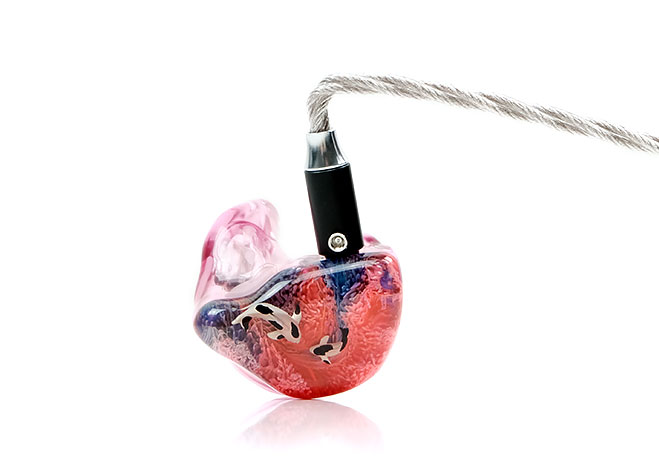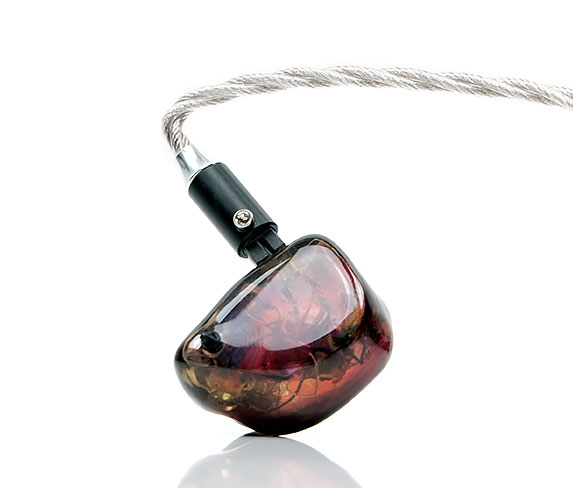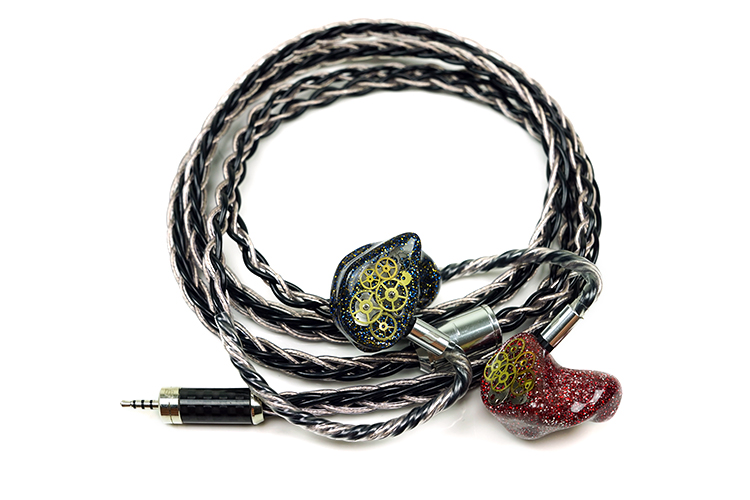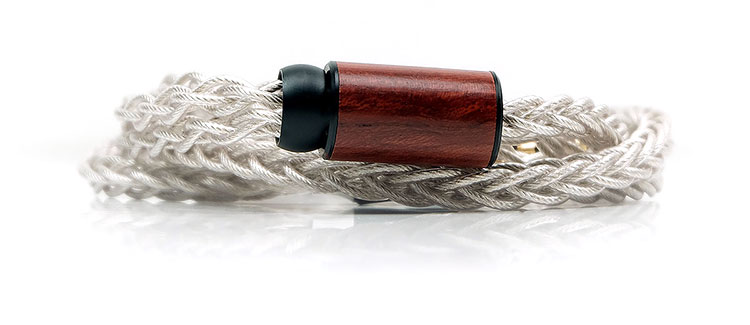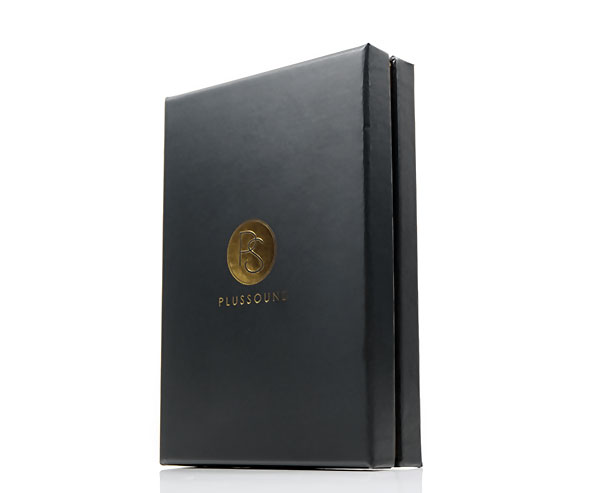Performance Impressions
Summary
When I spoke to PLUSSOUND about the performance goals, Christian spoke to me about trying to deliver a slightly different timbre but retain most of the technical aspects of the Tri-Silver cable, hence the introduction of copper.
And in a way, they have succeeded in doing just that. The X6 Palladium-plated Hybrid retains a high degree of separation and holographic prowess with the monitors we tested it with. these are traits I have come to associate the Tri-Silver with since our review last year.
However, there is just a shade more sweetness in the treble delivery and a marked elevation in low-end warmth to go along with it. No doubt the palladium-plated copper has made its presence felt.
But before you run off with the impression that this is a warm and fuzzy cable let me tell you this is not the case. The mix of wiring does a remarkably good job of maintaining a good treble presence but at the same time injecting some wetness and a bit more body to that presence.
Timbre
Hence, the term ‘sweetness’ when defining the timbre from the treble performances from the likes of monitors such as the tia Trio and to an extent Noble Audio’s Khan. And yes, the X6 Palladium-Plated Hybrid does sound different to the drier and slightly more strident Tri-Silver top-end signature.
Some might prefer that cleaner more neutral sound the Tri-Silver delivers which is not just evident in how treble generally sounds but right throughout. A key reason is that enhanced warmth from the X6’s low-end which produces what I think is a more agreeable harmonic balance in most of the monitors we tested.
Even though the extension and punch on the Tri-Silver is just as good, and in the case of the X8 probably better, you do not really hear that same fullness and inviting warmth that the Palladium-plated Hybrid offers.
However, one important note. This just not a simplistic blast of warmth. What I did pick up during testing was the level of detail present in the texture of notes when paired with the X6. This is a little different from cables like the Satin Audio Athena.
The Athena tended to sound a shade smoother even if its low-end is more elevated sounding. I suspect the excellent treble weighting on the X6 Palladium-Plated Hybrid injects a bit more odd-harmonic composure and the better contrast. This, in turn, ekes out more perceived micro-detail clarity, particularly in dynamic driver texture such as the tia Trio and Nobel Khan.
Staging
If you end up opting for the X8 version of this cable you will be in end-game territory. I only say this because the dynamic range of the X8 Tri-Silver is slightly better but the gap is not huge. I would guess already the X8 Palladium-Plated Hybrid is the best of the lot and I look forward to hearing how that performs someday.
That being said I felt the dynamic range and how open the X6 sounded was very competitive compared to bigger cables such as the 24AWG EA Janus 8-wire where the perceived gap was minimal. Staging on the Janus sounds closer to you and denser whereas the X6 sounds a little more holographic, airier and neutral in its positioning save for a slightly elevated low-end emphasis.
By comparison, the PS’s own Tri-Silver has a punchier tighter low-end and the more forward sounding of the two cables for top-end presence. The Palladium-Plated Hybrid tapers off the treble aggression and height for a smoother sound but also has the fuller weightier low-end. The X6, when volume adjusted, can sound the deeper and potentially the more planted of the two, particularly on dynamic driver monitors.
Synergy
We tested the X6 Palladium-plated hybrid with around 5-6 monitors including the Nobel Audio Khan, 64 Audio’s tia Trio, JH Audio’s Layla, and the VE Elysium.
What I personally found from that testing was that the better synergy pairings were those where you either wanted to soften edgy treble or enhance and sweet the timbre whilst opening the presentation up a bit more.
In all instances, outside of the VE Elysium’s stock cable which is a high-end aftermarket cable anyhow, the X6 brought significant upgrades to the performance of each monitor over their own supplied cable.
Particularly so for the Khan and Layla where the Khan can be treble edgy and the Layla a bit dark and dense without the right pairing. With the Layla, it is like a veil is lifted compared to the stock cable regardless of the bass boost setting. Treble is much cleaner, energetic and airier which in turn helps with mids clarity and instrumental separation. The dynamic range improvement using the X6 is also massive.
On the Khan, I preferred the X6 performance compared to the X8 Tri-Silver. Not due to any technical advantage but rather how it added a little more wetness to the treble which I tend to look for as the Khan treble can be quite hard sounding.
The X8 Tri-Silver sounded the edgier of the two cables with a bit more sibilance and splashiness from the upper mids onwards. The X6 synergy doesn’t necessarily dull down the treble presence but rather softens the attack and adds a bit more body in the process.
Select Comparisons
All comparison work was done with a single monitor and source to ensure consistency of outcomes, in this case, 64 Audio’s Tia Trio and Lotoo’s PAW Gold Touch.
Effect Audio Janus
$1399
Technical
I tend to think of this cable starting the aftermarket palladium craze. This is not one cable, but two ‘Hall Of Famers’ comprising of the bassy Basso and the richer mid-centric dynamic. The one we are comparing here is the Dynamic version.
The Janus is a 1.2m 24AWG cable so slightly bigger than the 26AWG gauge of the X6 and you can feel that in the way it handles and the overall weight. It is also an 8-wire cable so heftier than the 6 wire X6 in terms of wire count and size.
The geometry and materials are also quite different despite both using palladium-plated copper. The Janus D uses an Ultra Purity OCC Palladium-Plated Copper & ‘EA Alloy Mix’. The mix is comprised of an in-house mix of gold-plated copper and a gold-alloy so it lacks a silver component.
The X6 Palladium-Plated Hybrid uses a higher-end palladium-plated silver rather than an alloy mix so the wiring is slightly on the more exotic side. It is also a Type 6 Litz build and the Janus D makes no mention of it being a Litz build. Not that the Janus D has ever gone green on me so the wiring has held up pretty well over the last year or so.
Design
Very different styling for these two cables. Due to the 24AWG 8-wire build, the Janus is the heavier and stiffer of the two by a fair margin. Both have excellent handling, however, with no memory retention. The Janus does use memory wire and has no chin cinch which some might find more uncomfortable.
The visual of the Janus is very striking. I remember describing the black and silver effect as quite a noir aesthetic and I sand by that. The X6 Palladium-Plated Hybrid is subtler in its tones which may suit those not wishing for their cables to stand out as much. I still prefer PS connectors over EA variants as they always seem sturdier even if slightly bulkier.
Performance
I honestly did not find any major dynamic range differences between these two cables despite the larger gauge/wire count (24/8) on the Janus compared to the 26AWG 6-wire X6 Palladium-plated hybrid. That did surprise me a little as I could detect differences on the Tri-Silver 8-wire using the same Lotoo PAW Gold Touch and Tia Trio pairing.
The differences between these two cables seem to focus on the bass solidity and lower-mids with the X6 Palladium-plated hybrid teasing out a shade more treble presence than the Janus dynamic.
The Janus low-end sounds a bit more explosive and physical. Some of that may be due to the 8-wire dynamic range capability tweaking out a bit more “oomph” in the tia Trio’s dynamic driver performance.
The Janus midrange timbre on the tia Trio is also denser sounding, particularly vocal and lower-mids instrumental notes. The X6 Palladium-plated hybrid has a slightly lighter touch, not quite as dense or close sounding and a bit more treble presence.
That additional treble presence delivers a bit more headroom on the tia Trio and in turn, allows the X6 Palladium-plated Hybrid to sound a shade airier and more open. You end up swapping that dense physical feel of the Janus but still retain some of the warmth and sweetness with the X6/Trio pairing.
Satin Audio Athena
$799
Technical
The Athena has a short-lived reign as Satin Audio’s flagship cable. That honor now rests on their new Zeus cable (watch this space). This particular version is their 8-wire equivalent priced at $799 and you can get a 4-wire version much cheaper. We also thought this to be good value for an award in 2019.
The Athena wire itself is a hybrid SP-OCC palladium-plated silver mixed with SP-OCC pure silver in a multi-size strand type 4 Litz geometry. The X6 Palladium-Plated Hybrid is a Type 6 Litz build but drops to 6-wire from the Athena’s 8. The mix though is different with both palladium-plated copper and silver for the X6 wire mix using a 3/3 split. A bit more palladium and a bit more expensive.
Design
Both have a really nice stylish finish but where the PS X6 really shows its pedigree is in that braiding. That’s the one weakness of the Athena, that looser braiding throw.
No doubt the Athena is quite pliant and it does seem to have an even softer PVC jacket. However, the braid has gaps and for me, this can be a bit dangerous in the long run with potential for unraveling or things catching in the gaps. Neither use memory wire but retain a very quiet level of microphonics which is a big plus.
Both cables have some nice barrel work and a wide variety of termination options. The Athena connectors are smaller profile than the X6 but rely more on glue to tighten rather than screws. The splitter is more eye-catching on the Athena and suits it’s silvery aesthetic perfectly. However, it is a shade heavier than the light anodized aluminum barrel of the X6.
Also, no chin cinch on the Athena and that’s a bit of a miss compared to the beautiful chrome cinch on the X6.
Performance
As an 8-wire compared to a 6-wire with the same gauge, there is a slight difference in dynamic range/volume with the Athena sounding the marginally louder of the two cables. The timbral differences between these two cables are quite subtle using the Tia Trio. I suspect both are aiming for that holographic yet smooth delivery.
If there is one area I am picking up consistently then it is the level of detail and contrast in the texture. To use a metaphor, the Athena is delivering broad brushstrokes of the same paint but the X6 Palladium-plated hybrid is using a fine art pen to fill in the smaller gaps.
I suspect what I am hearing here is a little bit more treble resolution and energy in the X6 palladium-plated hybrid injecting itself into the midrange timbre of the tia Trio performance. This injection adds additional contrast that can help highlight subtle micro-detail a bit better.
On the low-end, the Athena is delivering a bit more body and warmth on a macro level and I expected that given its 8-wire build and general tuning. However, it is the devil in the detail again. The X6 PPH sounds tighter, better defined with less bloom and mid-bass warmth using the tia Trio.
PLUSSOUND Tri-Silver X8
$1599.99
Technical
Until the X8 version of the Palladium-Plated Hybrid, the X8 Tri-Silver was PLUSSOUND’s top dog, the big kahuna so to speak. Not anymore. Heck, even the X6 version we have here is only $100 less so it seems very fair to compare the two to see which one is right for you.
The composition here is different though the geometry is the same. Both cables use a Type 6 Litz 26AWG geometry builds but the Tri-Silver uses 3 elements compared to the two inside the Palladium-Plated Hybrid. The 3 are palladium-plated-silver, gold-plated silver, and pure silver. Only 1 cable is palladium-plated and the core composition is all based on silver wire.
The X6 palladium-plated hybrid uses copper and silver but both are plated with palladium. So one less element but a higher contrast in conduction properties and more resistance shaping from palladium than the Tri-Silver.
Design
Aesthetically the X8 Tri-Silver has a slight edge for me but really it is due to having simply more girth to look at. It is shinier if that means something to buyers. The transparent PVC lets the silver core wire shine whereas the X6 is a shade muted in comparison. That’s a preference thing in all reality.
Physics does play a role in the design of these two cables. The 8-wire 26AWG Tri-Silver is a bigger cable than the 6-wire X6 Palladium-Plated Hybrid. That means more wire to bind and braid so the handling is slightly different with the Tri-Silver the marginally stiffer. They use the exact same PVC jacket so it is not an inferior finish but rather just simply more wire.
The weight gap is not as big as you might expect due to the X8 Tri-Silver use of a rosewood splitter. Now, this will not always be the case because you can opt for heavier splitters but it does show you how much of the weight of a cable can be determined by the barrels you choose.
Outside of the splitter, both cables are terminated with the same connector and jack barrels and have no memory wire so there is next to no difference there between the two.
Performance
As expected, there is a tiny difference in the dynamic range of these two cables given the Tri-Silver is an 8-wire and the X6 is a 6-wire but the gap is not that huge. The major difference is in the timbre and unique emphasis they tease out of the Tia Trio performance.
The Tri-Silver/tia Trio is more exacting, cleaner and a little drier. It delivers a bit more upper mids and treble emphasis and a slightly tighter low-end on the Tia Trio.
The X6 palladium-plated hybrid is warmer and richer in its delivery and the more ‘planted sounding’ of the two cables. It has the greater weight and fullness on the Tia Trio’s low-end and a bit more body and even-harmonic balance in its timbre throughout. Most notably the lower-mids, vocal timbre and lower treble on the Tia trio sound creamier with a bit more sustain in instrumental notes.
On the Tri-Silver you sense a bit more focus, especially instrumental separation, but the notes have slightly less decay leading to that drier description. Most likely pulling from a more dominant treble presence, that in turn, tilts the harmonic balance of the tia Trio away from warm to neutral.
Overall, the X6 Palladium-plated Hybrid is the smoother, fuller sounding cable with the Tia Trio. The Tri-Silver is the cleaner, more neutral-sounding cable pairing with the tia Trio.
Our Verdict
This is a very smartly ‘tuned’ high performing cable from PLUSSOUND. It takes the technical prowess from the Tri-Silver and adds more body, smoothness and an altogether sweeter sounding timbre. I can see this being a much more flexible choice than the Tri-Silver in terms of synergy with a wide range of monitors. Certainly, it is an excellent match for the picky Noble Audio Khan.
Do not get me wrong, the Tri-Silver is perfectly suited to those who want to tease out more treble and a cleaner more neutral tone. For $100 more the X8 Tri-Silver does have a small edge in dynamic range and separation compared to the X6 Palladium-Plated Hybrid. However, I honestly think the majority of buyers will gravitate to the natural tone of the X6.
By the way, this cable is built to last and I can’t overstate that enough given how much rough and tumble it is like to get being a portable accessory. PLUSSOUND has always been excellent in that regard and X6 Palladium-plated Hybrid is no exception.
X6 Palladium-Plated Hybrid Specifications
- Gauge: 26AWG
- Core Count: 6 (comes in 4 and 8 also)
- Geometry: Type 6 Litz
- PS Insulation
- Proprietary dampening core
- Anodized aluminum splitter & Chin cinch
- Length: 1.2m (longer upon request)


